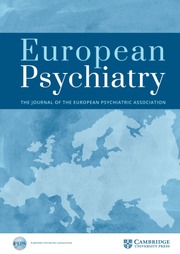Article contents
Dynamic of NAA and BOLD After Single Short Stimulus in Motor Cortex of Schizophrenia Patients
Published online by Cambridge University Press: 23 March 2020
Abstract
The aim of this study was the analysis of dynamics of motor cortex metabolite in the norm and in early stage of schizophrenia in period of BOLD response to event related single stimulus.
The patients group consisted of 9 mails of 16–28 years old in initial stage of schizophrenia and in remission. The group of 9 age matched healthy mails was used as a control.
Phillips Achieva 3.0 T scanner was used for the study. Volume of interest in motor cortex was localized on the base of fMRI. 1Н МR spectra were run using synchronization of FID signals acquisition (PRESS, TE = 30 ms TR = 3000 ms) with dynamics of BOLD response at the same paradigm.
The BOLD signal in both groups demonstrated maximum at the 6th s after target stimulus, however its value was reliably lover in schizophrenia in comparison with the control. The only [NAA] in normal motor cortex was changed after stimulation. The stable values of [NAA], [Cr] and [Cho] were observed in dynamic of resting state as well. [NAA] in normal cortex statistically significantly decreased at the 12th s after stimulus presentation and returned to initial value at the 15th s.
Different behavior of [NAA] in the norm and schizophrenia might be related with a difference in location (or activity) of aspartoacylaze (ASPA). Decreased expression of glutamate transporters in schizophrenia could also reduce consumption of NAA as a source of acetate in synthesis of AcCoA which is used for restoration of ATP.
The authors have not supplied their declaration of competing interest.
Information
- Type
- e-Poster viewing: Neuroimaging
- Information
- European Psychiatry , Volume 41 , Issue S1: Abstract of the 25th European Congress of Psychiatry , April 2017 , pp. S629
- Copyright
- Copyright © European Psychiatric Association 2017
- 1
- Cited by


Comments
No Comments have been published for this article.